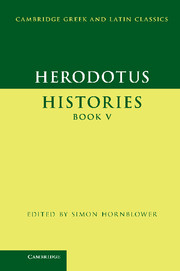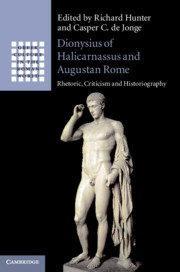Refine search
Actions for selected content:
23990 results in Ancient history
6 - Coins and Daily Life
-
- Book:
- From Caesar to Augustus (c. 49 BC–AD 14)
- Published online:
- 03 October 2018
- Print publication:
- 25 October 2018, pp 170-188
-
- Chapter
- Export citation
Abbreviations
-
- Book:
- Writing and Society in Ancient Cyprus
- Published online:
- 08 October 2018
- Print publication:
- 25 October 2018, pp xvii-xviii
-
- Chapter
- Export citation
Maps
-
- Book:
- Writing and Society in Ancient Cyprus
- Published online:
- 08 October 2018
- Print publication:
- 25 October 2018, pp xiv-xiv
-
- Chapter
- Export citation
1 - Timeline
-
- Book:
- From Caesar to Augustus (c. 49 BC–AD 14)
- Published online:
- 03 October 2018
- Print publication:
- 25 October 2018, pp 192-196
-
- Chapter
- Export citation
2 - Competition, Legitimacy and Civil War (49–44 BC)
-
- Book:
- From Caesar to Augustus (c. 49 BC–AD 14)
- Published online:
- 03 October 2018
- Print publication:
- 25 October 2018, pp 23-56
-
- Chapter
- Export citation
Bibliography
-
- Book:
- Writing and Society in Ancient Cyprus
- Published online:
- 08 October 2018
- Print publication:
- 25 October 2018, pp 245-268
-
- Chapter
- Export citation
Introduction
-
- Book:
- Writing and Society in Ancient Cyprus
- Published online:
- 08 October 2018
- Print publication:
- 25 October 2018, pp 1-3
-
- Chapter
- Export citation
Acknowledgements
-
- Book:
- Writing and Society in Ancient Cyprus
- Published online:
- 08 October 2018
- Print publication:
- 25 October 2018, pp xv-xvi
-
- Chapter
- Export citation
Contents
-
- Book:
- From Caesar to Augustus (c. 49 BC–AD 14)
- Published online:
- 03 October 2018
- Print publication:
- 25 October 2018, pp v-vi
-
- Chapter
- Export citation
5 - Representing the Augustan Principate (31 BC–AD 14)
-
- Book:
- From Caesar to Augustus (c. 49 BC–AD 14)
- Published online:
- 03 October 2018
- Print publication:
- 25 October 2018, pp 117-169
-
- Chapter
- Export citation
Copyright page
-
- Book:
- Writing and Society in Ancient Cyprus
- Published online:
- 08 October 2018
- Print publication:
- 25 October 2018, pp vi-vi
-
- Chapter
- Export citation
1 - Approaching Coinage in the Late Roman Republic
-
- Book:
- From Caesar to Augustus (c. 49 BC–AD 14)
- Published online:
- 03 October 2018
- Print publication:
- 25 October 2018, pp 1-22
-
- Chapter
- Export citation
5 - The Production of Ancient Coinage (by Andrew Meadows)
-
- Book:
- From Caesar to Augustus (c. 49 BC–AD 14)
- Published online:
- 03 October 2018
- Print publication:
- 25 October 2018, pp 209-211
-
- Chapter
- Export citation
Frontispiece
-
- Book:
- Writing and Society in Ancient Cyprus
- Published online:
- 08 October 2018
- Print publication:
- 25 October 2018, pp iv-v
-
- Chapter
- Export citation
Figures
-
- Book:
- Writing and Society in Ancient Cyprus
- Published online:
- 08 October 2018
- Print publication:
- 25 October 2018, pp ix-xii
-
- Chapter
- Export citation
3 - Glossary (by Andrew Meadows, updated and revised by the author)
-
- Book:
- From Caesar to Augustus (c. 49 BC–AD 14)
- Published online:
- 03 October 2018
- Print publication:
- 25 October 2018, pp 199-205
-
- Chapter
- Export citation
Contents
-
- Book:
- Writing and Society in Ancient Cyprus
- Published online:
- 08 October 2018
- Print publication:
- 25 October 2018, pp vii-viii
-
- Chapter
- Export citation

Herodotus: Histories Book V
-
- Published online:
- 16 October 2018
- Print publication:
- 12 December 2013
-
- Textbook
- Export citation

Dionysius of Halicarnassus and Augustan Rome
- Rhetoric, Criticism and Historiography
-
- Published online:
- 12 October 2018
- Print publication:
- 01 November 2018
Introduction
-
-
- Book:
- The World through Roman Eyes
- Published online:
- 24 September 2018
- Print publication:
- 11 October 2018, pp 1-23
-
- Chapter
- Export citation
